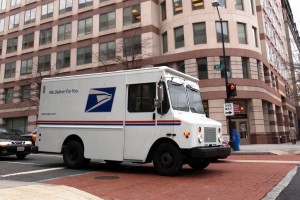
The Postal Service handles more than 44% of the world's mail volume, delivering more mail to more addresses and to a larger geographic area than any other postal administration in the world.
The U.S. Postal Service plans to purchase 900 new hybrids as well as 1,000 E-85 ethanol-capable vehicles as it replaces some 6,500 vehicles this year.
The balance of the Government Services Administration buy for the Postal Service will be fuel-efficient, four-cylinder vehicles, which will replace aging vehicles at postal facilities across the country. Virtually all of the vehicles will be acquired from U.S. manufacturers.
There was no cost to the Postal Service for the vehicles. GSA bore all purchase and distribution expenses.
With 220,000 vehicles, the Postal Service operates and maintains the largest civilian fleet in the country. When added the 1,900 vehicles from GSA will bring the total number of alternate fuel-capable vehicles in the Postal Service fleet to more than 43,000, postal officials said.
“With our fleet traveling more than 1.2 billion miles a year, the Postal Service consistently looks for ways to reduce the environmental footprint that results from visiting every home and business in America six days a week,” said Sam Pulcrano, vice president, Sustainability. ” The GSA fleet upgrade program will help us continue these strategies,” he said.
“This is a unique opportunity for the Postal Service to continue work on our goals for improved fuel economy, greenhouse gas reductions, and on our position as an environmental leader,” said Wayne Corey, manager, Vehicle Operations, who is overseeing the vehicle delivery.
The Postal Service also has increased alternative fuel use by 41% since 2006, and plans to reduce petroleum use by 20% over the next five years. Replacing aging vehicles with more fuel-efficient and alternative fuel-capable vehicles is central to reaching that goal.
The Postal Service, which has long history of championing new forms of transportation from trains to aircraft, has been honored with more than 70 major environmental awards in recent years.
The awards include 40 White House Closing the Circle awards for environmental stewardship and the 2009 Climate Change Champion of the Year Award for efforts to reduce greenhouse gas emissions.
The Postal Service is also experimenting with three-wheeled, electric vehicles in Florida, California and Arizona that have zero greenhouse gas emissions (if you ignore how the electricity s generated) and cost 4 cents a mile to operate. It is also two, fourth generation fuel-cell Chevrolet Equinox hydrogen fuel-cell vehicles, which are delivering mail in Irvine, CA, and in Washington, DC.
It also has 35 delivery vehicles in Florida that run on propane fuel and another 300 vehicles nationwide that are powered by biodiesel fuel.
Earlier this year, the GSA announced it intended to purchase more 14,500 vehicles for the federal government’s fleet as part of the economic stimulus package.
The Postal Service handles more than 44% of the world’s mail volume—delivering more mail to more addresses and to a larger geographic area than any other postal administration in the world.
It too is struggling as the Great Recession continues to grow. This year, only 180 billion pieces of mail will move through the system, a decline of 32 billion pieces from the 212 billion pieces handled in fiscal year 2007, which ended just before the onset of the recession in the fall of 2008. This mail volume loss resulted in a revenue decline of $12 billion, about one-sixth of annual revenue.


It’s encouraging to see government interest in switching over to green energy. There’s always so much focus on consumer cars, but hybrid-electric fleet vehicles would probably make an even greater impact than cars like the Prius and the Chevy Volt. Some startup companies have already ventured into this industry — Bright Automotive, Miles Electric Vehicles, and Pheonix Motorcars all have truck / van options with EV or PHEV powertrains.
If history is any guide, as soon as the Republicans get in office again they will not only put an end to this program, but will also mandate that all government vehicles use the least efficient gas guzzling engines available. Like when Reagan ripped the solar panels off the roof of the White House that Carter had installed and killed the SynFuels program.